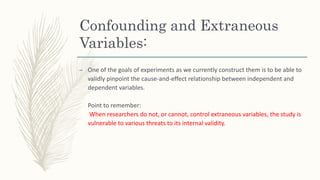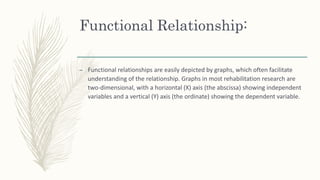V ariable by nadia sarwar
- 1. Topic: Variables Prepared by: Nadia Sarwar
- 2. Contents: â Variable â Independent Variables â Levels of Independent Variables â Active and Assigned Variables â Dependent Variables Intervening Variables â Confounding and Extraneous Variables â Functional Relationships â References
- 3. Variables and its types: â Variables are aspects that change over the course of research, whether clinical or not, as well as clinical practice itself. â Understanding their nature and function is critical, certainly for clinical practice, and, in research, particularly for experimentation. âTypes of Variable: They are broadly designated as independent and dependent variables, with the former presumed to be causes and the latter presumed to be effects of those causes.
- 4. Independent Variable: â Independent variables are aspects of a study that a scientist-practitioner either controls or chooses. â They are independent because they do not rely on other variables â for their changes. â They are causes of outcomes, or at least presumed causes of outcomes. Example: Treatment
- 5. Levels of Independent Variable: â Any independent variable must have at least two values; if there is only one value, the aspect does not vary, and it is a constant, not a variable. Each value of an independent variable is called a level of the variable. â Example: 1) Acoustic condition â 2) Effect of treatment on shoulder pain
- 6. Active and Assigned Variables: â Some independent variables allow the researcher to have complete control. For example, if a scientist-practitioner is comparing the effects of two different treatments on a population of 12-year-old children with autism â there are some conditions of interest in which participants cannot be randomly assigned or the researcher can choose but not control. For example, motor ability in children with cerebral palsy compared with children with typical motor ability
- 7. 2) Dependent Variable: â Dependent variables are the outcomes of a study, whether clinical intervention or not. In the case of clinical intervention, they are the behaviors we wish to help change. They are dependent because their values depend on changes in the independent variable. â It is critical to recognize that, for purposes of an experiment, a dependent variable must be operationally defined. That is, the researcher must decide how to measure the outcome. It is not enough to say that range of motion is being measured; the metric used (degrees, in this case) must be specified. Likewise, it is not enough to measure âfluencyâ; the researcher must specify how the value will be determined (e.g., by counting the number of dysfluencies per 100 words).
- 8. Intervening Variable: â Hegde7 describes a type of variable he labels âintervening.â These are largely mental processes that supposedly âinterveneâ between input and outcome. Examples are intelligence, motivation, and executive function. â We do not deny the existence of these processes and they are extremely difficult to measure, if measurable at all. Thus, their experimental value is questionable at best.
- 9. Confounding and Extraneous Variables: â One of the goals of experiments as we currently construct them is to be able to validly pinpoint the cause-and-effect relationship between independent and dependent variables. Point to remember: When researchers do not, or cannot, control extraneous variables, the study is vulnerable to various threats to its internal validity.
- 10. Functional Relationship: â Functional relationships are easily depicted by graphs, which often facilitate understanding of the relationship. Graphs in most rehabilitation research are two-dimensional, with a horizontal (X) axis (the abscissa) showing independent variables and a vertical (Y) axis (the ordinate) showing the dependent variable.
- 11. References: 1. Linacre JM, Heinemann AW, Wright BD, et al: The structure and stability of the Functional Independence Measure, Arch Phys Med Rehabil 75:127â 132, 1994. 2. Ryan S: The effects of a sound-field amplification system on managerial time in middle school physical education settings, Lang Speech Hear Serv Schools 40:131â137, 2009. 3. Hinman RS, Heywood SE, Day AR: Aquatic physical therapy for hip and knee osteoarthritis: results of a single-blind randomized controlled trial, Phys Ther 87:32â43, 2007. 4. Koutsoftas AD, Harmon MT, Gray S: The effect of Tier 2 intervention for phonemic awareness in a response-tointervention model in low-income preschool classrooms, Lang Speech Hear Serv Schools 40:116â130, 2009. 5. Harcourt School Publishers: Scientific Research Base, Harcourt Trophies, Orlando, Fla, 2002, Author. 6. Invernizzi M, Sullivan A, Meier J: Phonological Awareness Literacy Screening for Preschool, Charlottesville, Va, 2001, University Press. 7. Hegde MN. Clinical Research in Communicative Disorders, ed 3, Austin, Texas: Pro-Ed; 2003. 8. Nelson LK: Research in Communication Sciences and Disorders, San Diego, 2009, Calif: Plural Publishing. 9. Goldstein EA, Heaton JT, Stepp CE, Hillman RE: Training effects on speech production using a hands-free electromyographically controlled electrolarynx, J Speech Lang Hear Res 50:335â351, 2007.











